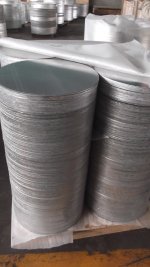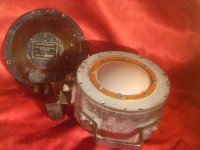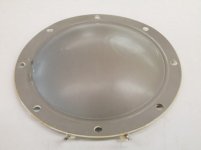Follow-up on the article:
As soon as it enters the HP940's diffraction throat, the wavefront is squished a second time... This is far from optimal, to put It mildly.
As soon as it enters the HP940's diffraction throat, the wavefront is squished a second time... This is far from optimal, to put It mildly.
Last edited:
Expensive without a quantity is only "feeling" 😀IOW, it's expensive
Here is link between quantity and "feeling" :
"The finest aluminum domes are made by Radian in the United States of America with a alloy nuance developed by Mitsubishi in order to build Japanese military planes during the war"
Last edited:
what about the JBL titanium non ribbed coated with Aquaplas (SL) dias?
Yeah the 2453H-SL is the driver i would buy if i needed a large compression driver from 500hz and up
Just purchased a pair of JBL 4722n speakers. - Page 130 - AVS Forum | Home Theater Discussions And Reviews
Some people think the 2450/2451 with an Aquaplas diaphragm sounds better. Something about the bigger magnet being an advantage. The 2451SL
Last edited:
maybe 2451SL with 2384 horn would be a winning combo for 2 way crossed to a 15" bass
is the 2384 suitable from 500Hz
is the 2384 suitable from 500Hz
2452SL(coated titanium) is probably the best overall value for a high performance 4" diaphragm driver. 2453SL looks similar.
Best performance still comes from a Beryllium dome.
Best performance still comes from a Beryllium dome.
Last edited:
Some people think the 2450/2451 with an Aquaplas diaphragm sounds better.
I remember someone was saying that one of the benefit of Aquaplas is, we can use Aquaplas woofer + Aquaplas tweeter for more consistent tone from bottom to top.
Oh well, it's so true at least psychologically. 😀
Dave Gunness did manage to get the HF to work quite a bit better on his EV MTA-22 manifolds than the traditional WE/Altec, but as is obvious in Pat Brown's test, the outcome is not very good when compared to a single driver, even before considering the increased distortion generated at high drive levels.Here's an article about dual versus a single driver attached to one horn. It doesn't seem worthwile, but the manifold (adapter) looks like a huge bottleneck with its sharp angles and pinched throats.
For dual-Axi2050 duties, a traditional WE/Altec type short exponential manifold might work better, perhaps with vanes near the exit.
I was very glad when finally got a return credit for the eight MTA-22 purchased around 1991.
As far as multiple drivers on a single horn, for Camplo's application there would be no need to double up the HF, just use appropriate low drivers sharing the horn.
Art
I could create a type of unity horn using multiple small woofers plus the exit...I'm not sure if I could pull it off.
When crossing as low as 400-500 Hz, small woofers are not required, 15" have been used with excellent results.I could create a type of unity horn using multiple small woofers plus the exit.
Using commercially available horns that already have the desired dispersion makes "pulling it off" a lot easier than making the entire multiple entry horn from scratch.
Also, there are MEH on the market with measurements and testing already done that are usable from 250Hz.
Red Spade Audio PSE-144
Red Spade Audio PSE-144
Expensive without a quantity is only "feeling" 😀
Here is link between quantity and "feeling" :
"The finest aluminum domes are made by Radian in the United States of America with a alloy nuance developed by Mitsubishi in order to build Japanese military planes during the war"
Yep I'm familiar with the origin of Duralumin, its applications and the Japanese successor: (Extra) Super Duralumin.
Attachments
Last edited:
When crossing as low as 400-500 Hz, small woofers are not required, 15" have been used with excellent results.
Using commercially available horns that already have the desired dispersion makes "pulling it off" a lot easier than making the entire multiple entry horn from scratch.
That is easily the simplest solution to the problems stated herein. Very nice idea. Any of something like this that you could show?
Dave Gunness did manage to get the HF to work quite a bit better on his EV MTA-22 manifolds than the traditional WE/Altec, but as is obvious in Pat Brown's test, the outcome is not very good when compared to a single driver, even before considering the increased distortion generated at high drive levels.
I was very glad when finally got a return credit for the eight MTA-22 purchased around 1991.
As far as multiple drivers on a single horn, for Camplo's application there would be no need to double up the HF, just use appropriate low drivers sharing the horn.
Art
Agreed, but I guess the HF extension was more related to the use of modern drivers than to the horns.
In 1934 WE engineers already got the 594A flat to 13k, controlled within 0.25 dB and with minimal group delay.
It is known WE modified a few 5.. drivers to let them play up to 20k for some of the experimental setups.
Last edited:
I really enjoy the large format JBL 2453h-SL on my 2384 waveguides. Measure smooth with decent high frequency extension.
User notnyt on AVSForum measured several JBL CD's on the waveguide and you can find detailed measurements there. Here is a summary of his listening tests/preferences:
Just purchased a pair of JBL 4722n speakers. - Page 129 - AVS Forum | Home Theater Discussions And Reviews
User notnyt on AVSForum measured several JBL CD's on the waveguide and you can find detailed measurements there. Here is a summary of his listening tests/preferences:
Just purchased a pair of JBL 4722n speakers. - Page 129 - AVS Forum | Home Theater Discussions And Reviews
And I really enjoyed your reviews of the Dutch&Dutch 8c and Kii Three, that I read only recently. Two of the most comprehensive loudspeaker reviews ever.
Big thumbs up!
Part of the 594A's secret sauce, still not fully decomposed after 85 years:
Big thumbs up!
Part of the 594A's secret sauce, still not fully decomposed after 85 years:
Attachments
Last edited:
These are front loaded horns are very easy to work with https://www.ddshorns.com/BassMid DVB 15H.pdf
You can run a nice low Qts pro driver from Precision Devices, RCF or a Beyma (see attached sim) in a 20L to 30L (depending on the Qtc you prefer) sealed box and sit just about any good quality commercial horn and compression driver on top.
Passive crossover around 500Hz to 600Hzor even up to 800Hz will work well, but the best solution by far is a decent DSP crossover / Eq which can really make this simple to build two way sing.
The DBX PA 2 DriveRack PA2 | dbx Professional Audio
is an unbelievable bargain as it sounds great, is easy to use and will teach first time DSP users a huge amount about the potential in DSP/ Eq sealed box loudspeakers.
You can run a nice low Qts pro driver from Precision Devices, RCF or a Beyma (see attached sim) in a 20L to 30L (depending on the Qtc you prefer) sealed box and sit just about any good quality commercial horn and compression driver on top.
Passive crossover around 500Hz to 600Hzor even up to 800Hz will work well, but the best solution by far is a decent DSP crossover / Eq which can really make this simple to build two way sing.
The DBX PA 2 DriveRack PA2 | dbx Professional Audio
is an unbelievable bargain as it sounds great, is easy to use and will teach first time DSP users a huge amount about the potential in DSP/ Eq sealed box loudspeakers.
Attachments
For a Synergy / MEH, Camplo could build conical horns composed of segments approaching an exponential curve. HF can be augmented by 2 or 4 small Celestion compression drivers attached to conical sections (throats) above and below the Axi2050. Likewise, the big BMS coaxial mids 4596 and 4599 (HE) could be supplemented with enough (4-8) tweets to generate the required amount of HF output.
So instead of mounting the mid/high driver(s) at the throat - the Danley way - you use a beasty dedicated mid and put the required number of HF drivers around It. The tweets may join the mid driver >5k.
In doing so (almost) the entire vocal range would be free of XO points.
So instead of mounting the mid/high driver(s) at the throat - the Danley way - you use a beasty dedicated mid and put the required number of HF drivers around It. The tweets may join the mid driver >5k.
In doing so (almost) the entire vocal range would be free of XO points.
Last edited:
- Home
- Loudspeakers
- Multi-Way
- Is it possible to cover the whole spectrum, high SPL, low distortion with a 2-way?


